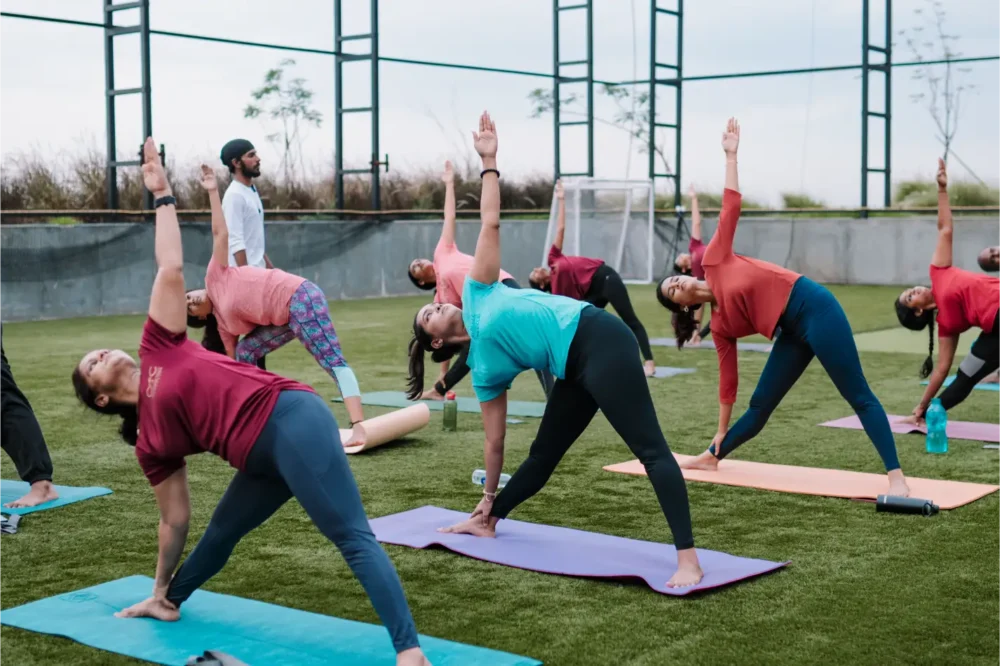Table of Contents
“Beginner’s Outdoor Yoga Guide in Chennai – Real Questions People Ask (Expert Answers)”
Introduction
Chennai has seen a huge rise in people choosing outdoor fitness, especially outdoor yoga. Beaches, parks, and calm morning environments make the city one of the best places in India to begin a yoga journey.
But when beginners decide to try outdoor yoga for the first time, dozens of questions appear.
This blog is written to answer those exact questions — the ones people actually search, ask, and wonder before their first outdoor session.
This is a clean, non-promotional, clarity-first, research-backed Q&A blog built to help beginners understand everything about starting outdoor yoga in Chennai.
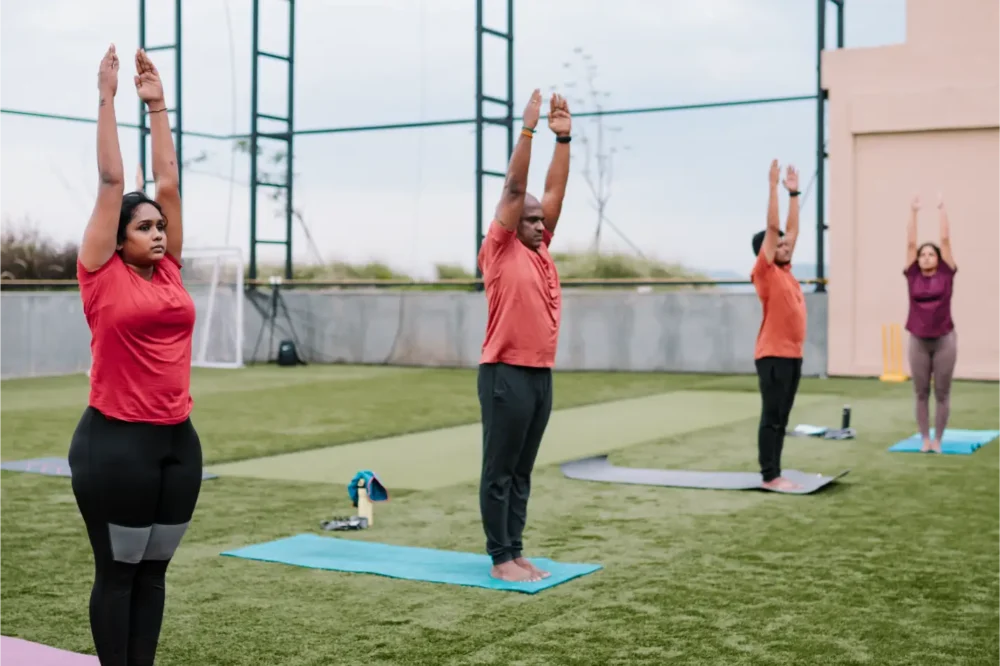
Q1. Is Outdoor Yoga Suitable for Absolute Beginners in Chennai?
Yes. Outdoor yoga is one of the easiest and most natural ways to begin your yoga journey.
For beginners, the biggest challenge is usually staying relaxed and not overthinking their performance. Outdoor environments make this easier.
Why beginners love starting outdoors:
- No studio pressure or performance anxiety
- Natural breeze helps regulate breathing
- Sunlight improves mood and energy
- Calming environment reduces tension
- Slow, grounding poses feel easier outside
- You feel connected to nature instead of a closed room
For someone taking their first steps into yoga, Chennai’s mornings — especially around Besant Nagar, Thiruvanmiyur, Marina Loop Road, Anna Nagar, and Tower Park — create an ideal environment.
Q2. What Should Beginners Expect in Their First Outdoor Yoga Session?
Many people assume yoga sessions outdoors are intense or advanced. In reality, beginner sessions are slow, structured, and paced carefully.
What usually happens:
- Warm-up movements for joints
- Breathwork to settle into the environment
- Simple standing and seated asanas
- Gentle stretches to ease stiffness
- Slow Surya Namaskar variations (beginner-friendly)
- Cool-down & guided relaxation
What NOT to expect:
- No forced stretching
- No high-intensity poses
- No pressure to “perform”
- No competition with others
Outdoor yoga embraces comfort, acceptance, and non-judgment — ideal for newcomers.
Q3. Is It Hard to Follow Instructions in an Outdoor Space?
Beginners often worry they might not hear instructions or might get confused. But outdoor classes are usually adapted for clarity.
Why outdoor instructions feel easier than expected:
- Natural acoustics in open areas
- Instructors use slow, clear cues
- Movements are visually demonstrated
- Group rhythm supports your learning
- The absence of echo helps concentration
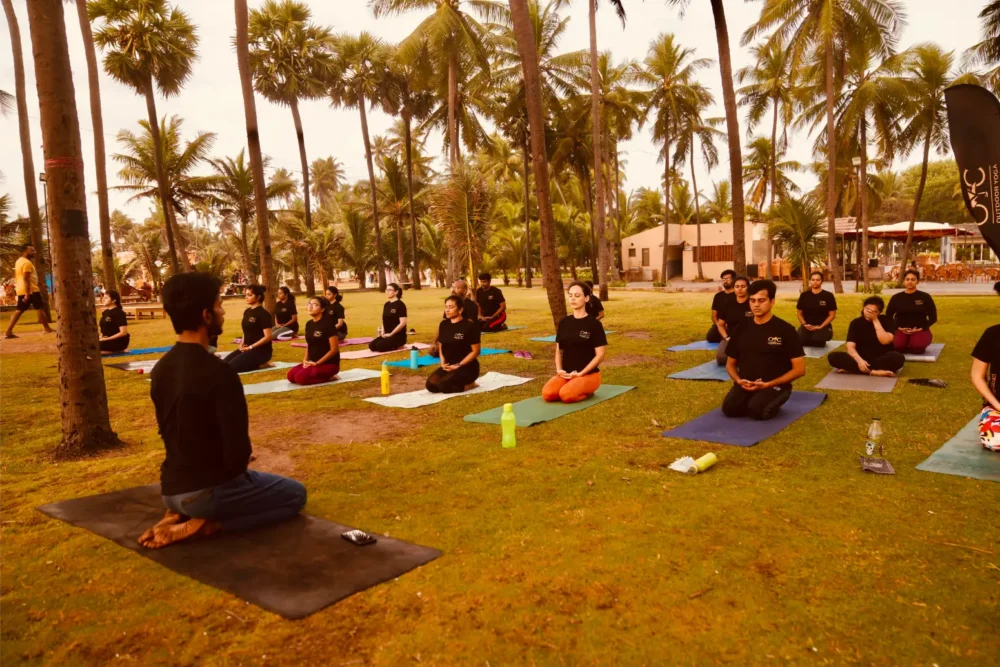
Most beginners say they learn faster outdoors because they feel less overwhelmed.
Q4. Which Outdoor Locations in Chennai Are Best for Beginners?
Chennai provides a mix of beaches, parks, and quiet corners that are perfect for beginner-friendly yoga.
Top beginner-friendly outdoor yoga spots:
✔ Besant Nagar Beach
Morning breeze + calm atmosphere + wide open space.
Beginners find it easy to adjust here.
✔ Thiruvanmiyur Beach
Less noisy compared to Marina.
Perfect for slow sequences and grounding.
✔ Anna Nagar Tower Park
Green cover + structured walking paths + clean atmosphere.
✔ Nageswara Rao Park, Mylapore
Popular among fitness enthusiasts and meditation groups.
✔ Kilpauk / Ampa Skywalk Surroundings
Urban yet peaceful pockets where many group sessions happen.
Why these spots work well:
- Safe
- Beginner-friendly crowd
- Clean environment
- Consistent airflow
- Easy accessibility
Beginners often stay consistent when locations feel comfortable and welcoming.
Q5. What Should Beginners Wear for Outdoor Yoga?
Wear breathable clothing that allows full movement.
Recommended clothing for Chennai weather:
- Light cotton tops
- Stretchable track pants / yoga tights
- Sports bra for women
- Sweat-wicking T-shirts during humid days
- Light jacket for breezy evenings
Avoid:
- Denim
- Tight or restrictive outfits
- Slippery fabrics
- Heavy accessories
Comfort = better balance + better focus.
Q6. What Essentials Should Beginners Bring to Outdoor Yoga Sessions?
Essentials are surprisingly simple.
Must-carry items:
- Yoga mat
- Water bottle
- Towel
- Comfortable footwear
- Sunscreen (morning sessions)
- Mosquito patch (season-based)
- Hair tie / headband
Optional:
- Small bolster or cushion (for sensitive knees)
- Mat cleaner wipes
- Cap during peak-sun seasons
Most beginners overpack initially — but outdoor yoga is effortless and minimalistic.
Q7. Are Outdoor Yoga Movements Different from Indoor Yoga?
The core principles are the same, but the atmosphere changes the way your body responds.
Differences beginners can feel:
1. Better breathing
Outdoor air improves inhalation–exhalation depth.
2. More grounded movements
Grass or sand creates natural stability.
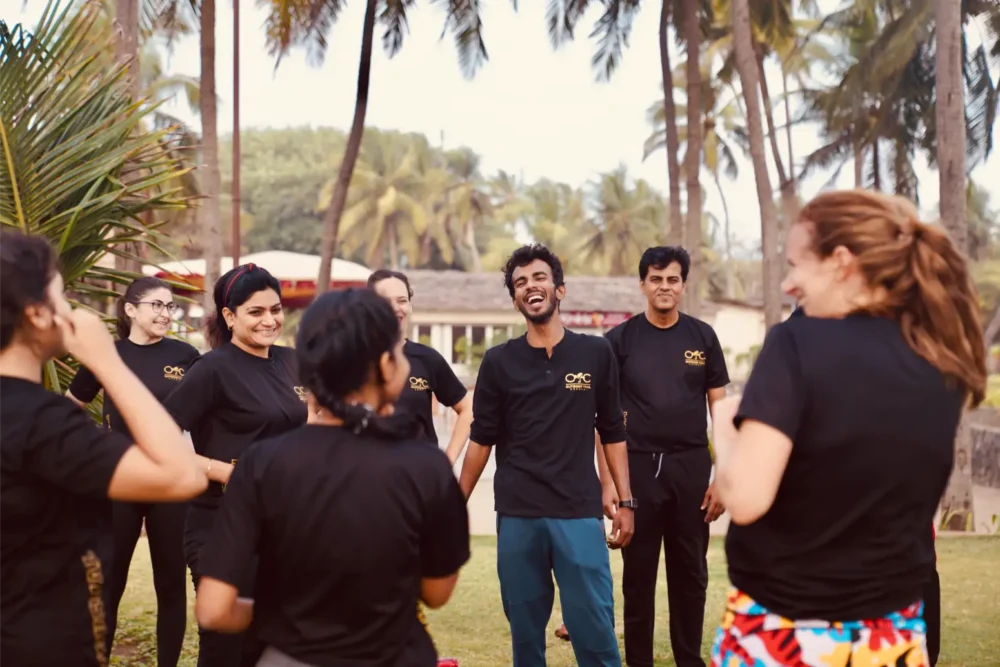
3. Calmer energy
Nature makes slow flows feel more peaceful.
4. Less pressure
Open space reduces self-criticism and fear of judgment.
5. Natural rhythm
Your breath aligns more easily with waves, wind, or birdsong.
Beginners often say outdoor yoga “feels easier” even when doing the same sequence they once struggled indoors.
Q8. Are There Any Challenges Beginners Face During Outdoor Yoga?
Yes — but they are minor and easy to handle.
Possible challenges:
- Wind may cause rustling sounds
- Sunlight may feel warm during late mornings
- Ground surfaces may feel uneven
- Occasional distractions from people walking around
How instructors solve it for beginners:
- Positioning mats in shaded areas
- Choosing quieter sections of the beach/park
- Slow-paced guidance
- Beginner-friendly mat alignment
- Teaching how to stay focused without strain
Outdoor yoga teaches beginners natural adaptability and emotional balance.
Q9. How Long Should a Beginner Practice Outdoor Yoga?
The ideal duration for beginners:
⏳ 35–50 minutes per session
This includes:
- 10 minutes warm-up
- 20–25 minutes asanas
- 5–10 minutes breathwork
- 5 minutes relaxation
Longer sessions can feel overwhelming in the first month.
Consistency > Intensity.
Weekly routine for beginners:
- 3 sessions/week ideal
- 4–5 sessions/week for faster flexibility
- Daily short stretching recommended
Outdoor yoga builds your confidence step-by-step.
Q10. Which Beginner Asanas Are Best for Outdoor Yoga?
Here are the most beginner-friendly poses to practice in Chennai’s environment:
1. Tadasana (Mountain Pose)
Improves posture and balance.
2. Sukhasana (Easy Pose)
Calming and ideal for breathwork.
3. Vrikshasana (Tree Pose)
Enhances focus when balancing in natural breeze.
4. Marjaryasana–Bitilasana (Cat-Cow)
Improves spine mobility.
5. Adho Mukha Svanasana (Downward Dog – beginner variation)
Strengthens legs and shoulders.
6. Balasana (Child’s Pose)
Perfect rest pose.
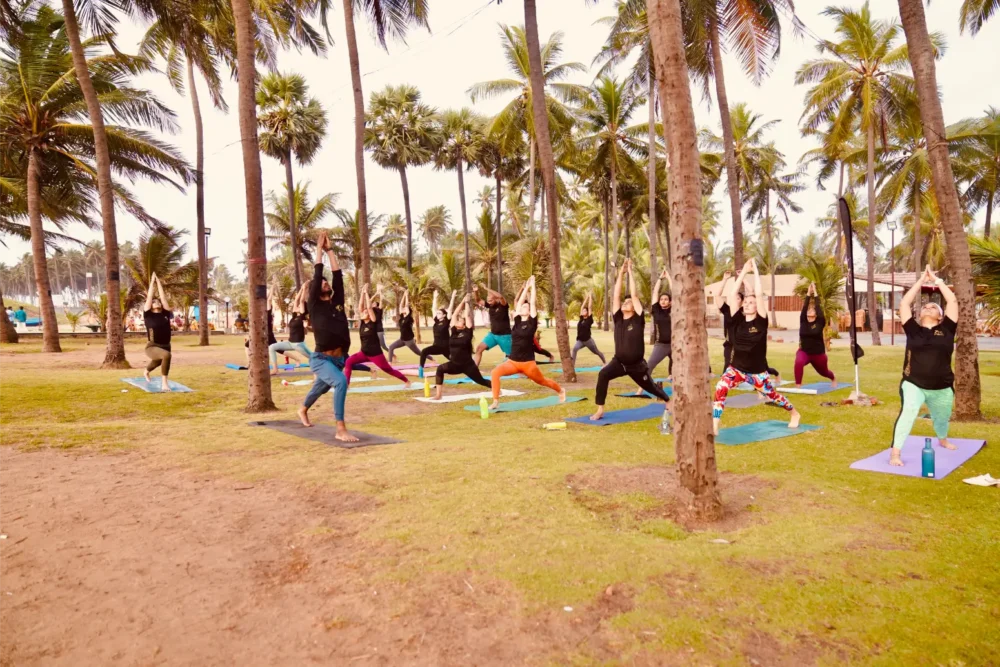
7. Surya Namaskar A (gentle flow)
Great for morning sessions.
These poses work naturally with outdoor elements like fresh air, sunlight, and open space.
Q11. Do Beginners Need to Be Fit Before Starting Outdoor Yoga?
Not at all.
Yoga builds fitness — you don’t need fitness to start yoga.
Beginners often start with:
- Stiff joints
- Low stamina
- Back or neck pain
- Sedentary lifestyle
- Weight gain
- Anxiety or stress
Outdoor yoga helps break all of this gradually and safely.
What improves first:
- Breath control
- Joint flexibility
- Stability
- Posture
- Sleep quality
- Mood consistency
The body adapts gently with regular practice.
Q12. Is Outdoor Yoga Better Than Indoor Yoga for Beginners?
Both have benefits, but outdoor yoga often creates a stronger beginner experience.
Why outdoor yoga wins:
- More oxygen
- Natural stress relief
- Encourages consistency
- Helps beginners feel less self-conscious
- Increases motivation
- Enhances mind–body awareness
- Promotes deeper breathing
Why beginners may prefer outdoor sessions:
- No AC dryness
- No noise from machines
- No closed walls
- No performance pressure
- No mirrors causing distraction
For most new learners, outdoor yoga becomes emotionally grounding.
Q13. How Can Beginners Stay Consistent With Outdoor Yoga?
Consistency is the biggest challenge for beginners in any fitness routine.
Tips to stay consistent:
- Choose a location close to home
- Set a fixed timing (morning/evening)
- Use a comfortable mat
- Track slow progress weekly
- Begin with 3–4 days a week
- Join a supportive community
- Avoid comparing yourself with others
- Focus on breath, not perfection
Once you complete the first 21 days, outdoor yoga easily becomes a lifestyle habit.
Q14. Should Beginners Combine Outdoor Yoga With Online Classes?
Yes — combining both is highly effective.
Why this hybrid method works:
- Online classes teach fundamentals
- Outdoor sessions refine posture
- Online practice offers flexibility
- Outdoor practice offers motivation
- Both together help track progress
Many beginners in Chennai follow this combined approach for faster improvement.
Q15. What Mindset Should Beginners Have Before Starting Outdoor Yoga?
The right mindset makes the journey easier and more enjoyable.
Beginner mindset guidelines:
- Be patient with your body
- Do not expect instant flexibility
- Accept natural mistakes
- Focus on breathing, not perfection
- Grow at your own pace
- Enjoy the environment
- Appreciate nature’s role in the practice

Outdoor yoga is less about performance and more about connection — with self and nature.
Conclusion
Outdoor yoga is one of the most naturally supportive environments for beginners in Chennai. Between the city’s beaches, parks, and gentle morning climate, starting your yoga journey outside can bring calmness, confidence, and a sense of balance that studio settings often cannot provide.
Beginners benefit from slower progression, grounding movements, stress relief, easier breathing, and a welcoming atmosphere. Whether you practice at Besant Nagar, Thiruvanmiyur, Kilpauk, Ampa Skywalk, Anna Nagar, or any open space near you, outdoor yoga offers a peaceful foundation to grow physically, mentally, and emotionally.
This Q&A guide answers everything beginners usually wonder before their first outdoor session — so you can begin your journey fully informed, relaxed, and ready to connect with nature.
